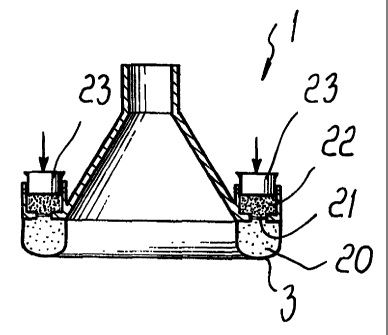Some of the information on this Web page has been provided by external sources. The Government of Canada is not responsible for the accuracy, reliability or currency of the information supplied by external sources. Users wishing to rely upon this information should consult directly with the source of the information. Content provided by external sources is not subject to official languages, privacy and accessibility requirements.
Any discrepancies in the text and image of the Claims and Abstract are due to differing posting times. Text of the Claims and Abstract are posted:
| (12) Patent: | (11) CA 2329251 |
|---|---|
| (54) English Title: | CUSTOMIZABLE FACE OR NOSE MASK FOR THE NONINVASIVE VENTILATION OF PATIENTS IN GENERAL |
| (54) French Title: | MASQUE FACIAL OU NASAL SOUPLE POUR VENTILATION NON INVASIVE DES PATIENTS EN GENERAL |
| Status: | Deemed expired |
| (51) International Patent Classification (IPC): |
|
|---|---|
| (72) Inventors : |
|
| (73) Owners : |
|
| (71) Applicants : |
|
| (74) Agent: | OSLER, HOSKIN & HARCOURT LLP |
| (74) Associate agent: | |
| (45) Issued: | 2009-04-07 |
| (86) PCT Filing Date: | 1999-05-11 |
| (87) Open to Public Inspection: | 1999-11-18 |
| Examination requested: | 2004-05-11 |
| Availability of licence: | N/A |
| (25) Language of filing: | English |
| Patent Cooperation Treaty (PCT): | Yes |
|---|---|
| (86) PCT Filing Number: | PCT/US1999/010300 |
| (87) International Publication Number: | WO1999/058198 |
| (85) National Entry: | 2000-10-19 |
| (30) Application Priority Data: | ||||||
|---|---|---|---|---|---|---|
|
A customized face
or nose mask (1) for the
non-invasive ventilation of
patients in general, which
comprises a mask body
(2) forming at least one
surface portion which can
be coupled to the face of
the patient. The peculiarity
of the invention consists
in that it comprises, at least
at the surface portion, a
chamber (3) for containing
at least one product
without shape memory
which can be activated to
produce a chemical, and/or
physical reaction for the
transformation of the at
least one product without
shape memory into a product
having shape memory which
spontaneously models itself on the patient's face.
La présente invention concerne un masque facial ou nasal souple (1) pour la ventilation non invasive de patients en général, qui comprend un corps de masque (2) formant au moins une coiffe qui vient s'adapter sur le visage du patient. Le masque selon l'invention offre la particularité de comprendre, au moins dans sa partie coiffe, une chambre (3) renfermant au moins un produit sans mémoire de forme qui, lorsqu'il est activé, produit une substance chimique et/ou une réaction physique entraînant la transformation de ce produit sans mémoire de forme en un produit à mémoire de forme qui épouse spontanément le modelé du visage.
Note: Claims are shown in the official language in which they were submitted.
Note: Descriptions are shown in the official language in which they were submitted.

For a clearer understanding of the status of the application/patent presented on this page, the site Disclaimer , as well as the definitions for Patent , Administrative Status , Maintenance Fee and Payment History should be consulted.
| Title | Date |
|---|---|
| Forecasted Issue Date | 2009-04-07 |
| (86) PCT Filing Date | 1999-05-11 |
| (87) PCT Publication Date | 1999-11-18 |
| (85) National Entry | 2000-10-19 |
| Examination Requested | 2004-05-11 |
| (45) Issued | 2009-04-07 |
| Deemed Expired | 2010-05-11 |
There is no abandonment history.
| Fee Type | Anniversary Year | Due Date | Amount Paid | Paid Date |
|---|---|---|---|---|
| Application Fee | $300.00 | 2000-10-19 | ||
| Registration of a document - section 124 | $100.00 | 2001-03-30 | ||
| Registration of a document - section 124 | $100.00 | 2001-03-30 | ||
| Maintenance Fee - Application - New Act | 2 | 2001-05-11 | $100.00 | 2001-05-11 |
| Maintenance Fee - Application - New Act | 3 | 2002-05-13 | $100.00 | 2002-04-29 |
| Maintenance Fee - Application - New Act | 4 | 2003-05-12 | $100.00 | 2003-04-30 |
| Maintenance Fee - Application - New Act | 5 | 2004-05-11 | $200.00 | 2004-04-29 |
| Request for Examination | $800.00 | 2004-05-11 | ||
| Maintenance Fee - Application - New Act | 6 | 2005-05-11 | $200.00 | 2005-05-02 |
| Maintenance Fee - Application - New Act | 7 | 2006-05-11 | $200.00 | 2006-04-26 |
| Maintenance Fee - Application - New Act | 8 | 2007-05-11 | $200.00 | 2007-04-24 |
| Maintenance Fee - Application - New Act | 9 | 2008-05-12 | $200.00 | 2008-04-28 |
| Final Fee | $300.00 | 2009-01-16 |
Note: Records showing the ownership history in alphabetical order.
| Current Owners on Record |
|---|
| MALLINCKRODT INC. |
| Past Owners on Record |
|---|
| BERGAMASCHI, PAOLO |
| FINI, MASSIMO |
| MALLINCKRODT HOLDINGS B.V. |